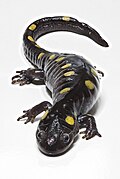Salamander
Salamander is a group of approximately 500 species of amphibians typically characterized by a lizard-like appearance, with slender bodies, blunt snouts, short limbs projecting at right angles to the body, and the presence of a tail in both larvae and adults.
Classification[edit]
Salamanders are part of the order Urodela, which also includes newts. The order is divided into nine families, with a diverse range of species and habitats.
Anatomy and Morphology[edit]
Salamanders range in size from the minute salamanders, with a total length of 2.7 cm (1.1 in), including the tail, to the Chinese giant salamander which reaches 1.8 m (5.9 ft) and weighs up to 65 kg (143 lb).
Habitat and Distribution[edit]
Salamanders are found in most parts of the world but are most numerous in the Northern Hemisphere. Many species are aquatic, but some are terrestrial, and some are capable of both modes of locomotion.
Behavior and Ecology[edit]
Salamanders are capable of regenerating lost limbs, as well as other damaged parts of their bodies. Researchers hope to reverse engineer the remarkable regenerative processes for potential human medical applications, such as in limb regeneration.
Conservation[edit]
Many species of salamanders are endangered, and some are threatened with extinction, due to habitat loss, pollution, disease, and other factors.
See Also[edit]
|
|
|
-
Spotted Salamander
-
Salamandra lanzai
-
Siren lacertina
-
Rough-skinned Newt
-
Proteus anguinus
-
Biofluorescent Patterns in Salamanders
-
Salamander
-
Necturus maculosus
-
Salamander Head
-
Salamander Olympus
-
Newt Amplexus
-
Embryonic Development of a Salamander
Ad. Transform your life with W8MD's Budget GLP-1 injections from $75


W8MD offers a medical weight loss program to lose weight in Philadelphia. Our physician-supervised medical weight loss provides:
- Weight loss injections in NYC (generic and brand names):
- Zepbound / Mounjaro, Wegovy / Ozempic, Saxenda
- Most insurances accepted or discounted self-pay rates. We will obtain insurance prior authorizations if needed.
- Generic GLP1 weight loss injections from $75 for the starting dose.
- Also offer prescription weight loss medications including Phentermine, Qsymia, Diethylpropion, Contrave etc.
NYC weight loss doctor appointmentsNYC weight loss doctor appointments
Start your NYC weight loss journey today at our NYC medical weight loss and Philadelphia medical weight loss clinics.
- Call 718-946-5500 to lose weight in NYC or for medical weight loss in Philadelphia 215-676-2334.
- Tags:NYC medical weight loss, Philadelphia lose weight Zepbound NYC, Budget GLP1 weight loss injections, Wegovy Philadelphia, Wegovy NYC, Philadelphia medical weight loss, Brookly weight loss and Wegovy NYC
|
WikiMD's Wellness Encyclopedia |
| Let Food Be Thy Medicine Medicine Thy Food - Hippocrates |
Medical Disclaimer: WikiMD is not a substitute for professional medical advice. The information on WikiMD is provided as an information resource only, may be incorrect, outdated or misleading, and is not to be used or relied on for any diagnostic or treatment purposes. Please consult your health care provider before making any healthcare decisions or for guidance about a specific medical condition. WikiMD expressly disclaims responsibility, and shall have no liability, for any damages, loss, injury, or liability whatsoever suffered as a result of your reliance on the information contained in this site. By visiting this site you agree to the foregoing terms and conditions, which may from time to time be changed or supplemented by WikiMD. If you do not agree to the foregoing terms and conditions, you should not enter or use this site. See full disclaimer.
Credits:Most images are courtesy of Wikimedia commons, and templates, categories Wikipedia, licensed under CC BY SA or similar.
Translate this page: - East Asian
中文,
日本,
한국어,
South Asian
हिन्दी,
தமிழ்,
తెలుగు,
Urdu,
ಕನ್ನಡ,
Southeast Asian
Indonesian,
Vietnamese,
Thai,
မြန်မာဘာသာ,
বাংলা
European
español,
Deutsch,
français,
Greek,
português do Brasil,
polski,
română,
русский,
Nederlands,
norsk,
svenska,
suomi,
Italian
Middle Eastern & African
عربى,
Turkish,
Persian,
Hebrew,
Afrikaans,
isiZulu,
Kiswahili,
Other
Bulgarian,
Hungarian,
Czech,
Swedish,
മലയാളം,
मराठी,
ਪੰਜਾਬੀ,
ગુજરાતી,
Portuguese,
Ukrainian














